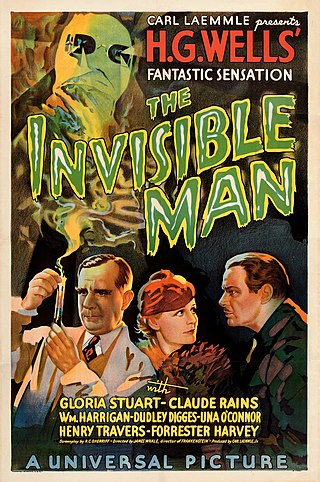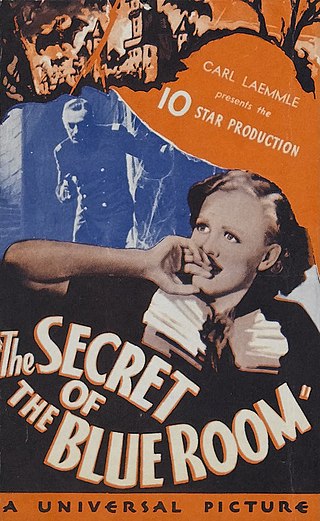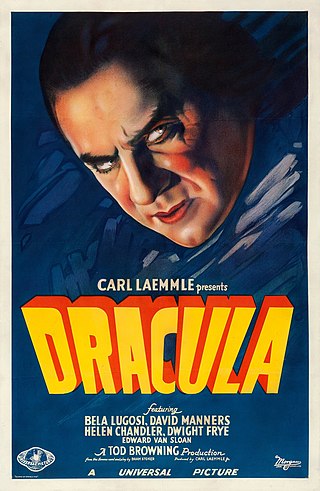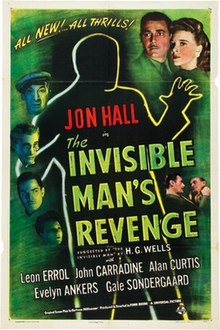
The Invisible Man is a 1933 American science fiction horror film directed by James Whale based on H. G. Wells' 1897 novel, The Invisible Man, produced by Universal Pictures, and starring Gloria Stuart, Claude Rains and William Harrigan. The film involves a Dr. Jack Griffin (Rains) who is covered in bandages and has his eyes obscured by dark glasses, the result of a secret experiment that makes him invisible, taking lodging in the village of Iping. Never leaving his quarters, the stranger demands that the staff leave him completely alone until his landlady and the villagers discover he is invisible. Griffin goes to the house of his colleague, Dr. Kemp and tells him of his plans to create a reign of terror. His fiancée Flora Cranley, the daughter of his employer Dr. Cranley, soon learn that Griffin's discovery has driven him insane, leading him to prove his superiority over other people by performing harmless pranks at first and eventually turning to murder.

Griffin, also known as the Invisible Man, is a fictional character who first appeared as the protagonist of H. G. Wells' 1897 science fiction novel The Invisible Man. In the original work, Griffin is a scientist whose research in optics and experiments into changing the human body's refractive index to that of air results in him becoming invisible. After becoming invisible, he wraps his head in bandages and dons a pair of goggles or glasses in order to enable others to see him. Unable to reverse the invisibility process, he descends into insanity and becomes a criminal.

The Invisible Man Returns is a 1940 American horror science fiction film directed by Joe May. The film stars Cedric Hardwicke, Vincent Price, Nan Grey and John Sutton. The film is a sequel to the 1933 film The Invisible Man, and the second film in the Invisible Man film series. The film is about Sir Geoffrey Radcliffe (Price) who is condemned for a murder he did not commit, which leads to him begging Dr. Frank Griffin (Sutton) to inject him with the invisibility serum despite Griffin's warning that the serum will drive him mad.

The Invisible Woman is an American science fiction comedy film directed by A. Edward Sutherland. It is the third film in Universal Pictures' The Invisible Man film series, following The Invisible Man and The Invisible Man Returns, the latter which was released earlier in the year. It was more of a screwball comedy than a horror film like the others in the series. Universal released The Invisible Woman on December 27, 1940.

Invisible Agent is a 1942 American action and spy film directed by Edwin L. Marin with a screenplay written by Curt Siodmak. The invisible agent is played by Jon Hall, with Peter Lorre and Sir Cedric Hardwicke as members of the Axis, and Ilona Massey and Albert Basserman as Allied spies.

The Black Cat is a 1941 American comedy horror and mystery film directed by Albert S. Rogell and starring Basil Rathbone. The film was a hybrid of style: being inspired by comedy "Old Dark House" films of the era as well as the 1843 short story "The Black Cat" by Edgar Allan Poe. It stars Basil Rathbone as Montague Hartley, the head of a greedy family who await the death of Henrietta Winslow so that they can inherit her fortune. When she is found murdered, an investigation begins into who might be the culprit. Alongside Rathbone and Loftus, the film's cast includes Hugh Herbert, Broderick Crawford, and Bela Lugosi.

The Invisible Ray is a 1936 American science-fiction horror film directed by Lambert Hillyer. It stars Boris Karloff as Dr. Janos Rukh, a scientist who comes in contact with a meteorite composed of an element known as "Radium X". After exposure to its rays begins to make him glow in the dark, his touch becomes deadly, and he begins to be slowly driven mad. Alongside Karloff, the film's cast includes Bela Lugosi, Frances Drake, Frank Lawton, Walter Kingsford, Beulah Bondi, Violet Kemble Cooper, and Nydia Westman.

Frankenstein Meets the Wolf Man is a 1943 American horror film directed by Roy William Neill and starring Lon Chaney Jr. as the Wolf Man and Bela Lugosi as Frankenstein's monster. This was the first of a series of later called "monster rallies" combining characters from several film series. This film's script written by Curt Siodmak follows The Ghost of Frankenstein and The Wolf Man. The film involves Larry Talbot who is brought back to life. Seeking a way to return to his death to escape his werewolf curse, he meets with gypsy Maleva who advises him that the only way to stay dead is to confer with Dr. Frankenstein. The doctor is long dead but his equipment is in working condition, leading Talbot to seek the help of scientist Dr. Mannering and Frankenstein descendant Baroness Elsa Frankenstein. Talbot then attempts to have his life sucked from his body and transferred into Frankenstein's monster.

Son of Dracula is a 1943 American horror film directed by Robert Siodmak with a screenplay based on an original story by his brother Curt Siodmak. The film stars Lon Chaney Jr., Louise Allbritton, Robert Paige, Evelyn Ankers, and Frank Craven. The film is set in the United States, where Count Alucard has just taken up residence. Katherine Caldwell (Allbritton), a student of the occult, becomes fascinated by Alucard and eventually marries him. Katherine begins to look and act strangely, leading her former romantic partner Frank Stanley (Paige) to suspect that something has happened to her. He gets help from Dr. Brewster (Craven) and psychologist Laszlo who come to the conclusion that Alucard is a vampire.

House of Frankenstein is a 1944 American horror film starring Boris Karloff, Lon Chaney Jr. and John Carradine. Based on a story by Curt Siodmak, it was directed by Erle C. Kenton and produced by Universal Pictures. The film is about Dr. Gustav Niemann, who escapes from prison and promises to create a new body for his assistant Daniel. Over the course of the film, they encounter Count Dracula, Larry Talbot, the Wolf Man, and Frankenstein's Monster.

House of Dracula is a 1945 American horror film released and distributed by Universal Pictures. Directed by Erle C. Kenton, the film features several Universal Horror properties meeting as they had done in the 1944 film House of Frankenstein. The film is set at the castle home of Dr. Franz Edelmann, who is visited first by Count Dracula and later by Larry Talbot, the Wolf Man, who are trying to cure their vampirism and lycanthropy, respectively. Talbot is eventually cured, which leads him to discover the body of Frankenstein's monster in a cave below the base of the castle. Edelemann takes the monster's body back to his laboratory but finds Count Dracula has awakened and by attacking his assistants, he captures Edelmann and forces a reverse blood transfusion, which gives Edelmann a split personality and makes him a killer.

The Raven is a 1935 American horror film directed by Louis Friedlander and starring Boris Karloff and Béla Lugosi. Billed as having been "suggested by" Edgar Allan Poe's 1845 poem of the same title, excerpts of which are quoted at a few points in the film, it was adapted from an original screenplay by David Boehm. Lugosi stars as a neurosurgeon obsessed with Poe who has a torture chamber in his basement, and Karloff plays an escaped murderer on the run from the police who Lugosi manipulates into doing his dirty work.

Universal Classic Monsters is a home video line based on a series of horror films primarily produced by Universal Pictures from the 1930s to the 1950s. Although not initially conceived as a franchise, the enduring popularity and legacy of the films and the characters featured in them has led the studio to market them under the collective brand name of Universal Studios Monsters. Steve Jones of USA Today described Universal's most famous monsters as "pop culture icons", specifically Dracula, Frankenstein, the Mummy, and the Wolf Man.

Captive Wild Woman is a 1943 American horror film directed by Edward Dmytryk. The film stars Evelyn Ankers, John Carradine, Milburn Stone, and features Acquanetta as Paula, the Ape Woman. The film involves a scientist, Dr. Sigmund Walters, whose experiments turn a female gorilla named Cheela into a human by injecting the ape with sex hormones and via brain transplants.

Calling Dr. Death is a 1943 Inner Sanctum mystery film. The "Inner Sanctum" franchise originated with a popular radio series and all of the films star Lon Chaney Jr. The movie stars Chaney Jr. and Patricia Morison, and was directed by Reginald Le Borg. Chaney Jr. plays a neurologist, Dr. Mark Steele, who loses memory of the past few days after learning that his wife has been brutally murdered. Aware of his wife's infidelity and believing he could be the killer, Steele asks his office nurse Stella Madden to help him recover his lost memories.
Shock Theater is a package of 52 pre-1948 classic horror films from Universal Studios released for television syndication in October 1957 by Screen Gems, the television subsidiary of Columbia Pictures. The Shock Theater package included Dracula, Frankenstein, The Mummy, The Invisible Man and The Wolf Man as well as a few non-horror spy and mystery films. A second package, Son of Shock, was released for television by Screen Gems in 1958, with 20 horror films from both Universal and Columbia.

The Secret of the Blue Room is a 1933 American pre-Code mystery film directed by Kurt Neumann and starring Lionel Atwill, Gloria Stuart, Paul Lukas, and Edward Arnold. A remake of the German film Geheimnis des blauen Zimmers (1932), it concerns a group of wealthy people who stay at a European mansion that features a blue room that is said to be cursed, as everyone who has stayed there has died shortly after. Three people suggest a wager that each can survive a night in the blue room.

Frankenstein is a film series of horror films from Universal Pictures based on the play version by Peggy Webling and the 1818 novel Frankenstein; or, The Modern Prometheus by Mary Shelley. The series follow the story of a monster created by Henry Frankenstein who is made from body parts of corpses and brought back to life. The rest of the series generally follows the monster continuously being revived and eventually focuses on a series of cross overs with other Universal horror film characters such as The Wolf Man. The series consists of the following films: Frankenstein (1931), Bride of Frankenstein (1935), Son of Frankenstein (1939), The Ghost of Frankenstein (1942), Frankenstein Meets the Wolf Man (1943), House of Frankenstein (1944), House of Dracula (1945) and Abbott and Costello Meet Frankenstein (1948).

Dracula is a film series of horror films from Universal Pictures based on the 1897 novel Dracula by Bram Stoker and its 1927 play adaptation. The series is a loose collection of films, with historians stating that the films all reference characters, events or at least passing knowledge of the 1931 English-language production of Dracula, with historians noting that Dracula's Daughter and Son of Dracula are more closely related to the 1931 film while the character of Dracula would make smaller appearances in later films such as House of Frankenstein and House of Dracula. After Dracula's Daughter, the character of Dracula and other vampires in the series became more Americanized, starting with the release of Son of Dracula, and the later House of films. The character of Dracula appears in all the films outside of Dracula's Daughter, where he is portrayed by Bela Lugosi, Lon Chaney Jr., and John Carradine in the House of films.

The Invisible Man is a film series by Universal Pictures. The series consists of The Invisible Man, The Invisible Man Returns, The Invisible Woman, Invisible Agent, The Invisible Man's Revenge and Abbott and Costello Meet the Invisible Man. The film series borrows elements from H. G. Wells's novel The Invisible Man, but it focuses primarily on the idea of a serum that causes someone to go invisible and its side-effects.



















